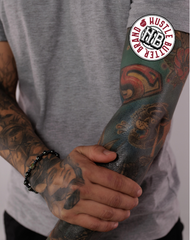Is it Normal for a New Tattoo to Peel?
Peeling, Flaking, and Itching: A Survival Guide for Tattoo Aftercare
We’ve all been there. You’re fresh out of the studio, your tattoo is looking flawless. But now it's been a few days and suddenly the top layer is starting to peel and the new piece is itching like crazy. Your first instinct might be to panic. Don’t.
We’re here to tell you - if you’re wondering, "is it normal for tattoos to peel?" The answer is yes.
Peeling, flaking, and itching are all part of the normal tattoo healing process. Those are signs that your body is doing exactly what it’s supposed to be doing: renewing and rebuilding the skin underneath your new tattoo.
If you are wondering what’s normal, or when to reach out to your artist, our guide breaks it all down: what to expect, what the healing process can feel like, and how to get through the peeling stage without damaging your tattoo or your skin.
Peeling, Flaking, and Itching Tattoos: Everything You Need to Know
Why is my tattoo peeling?
Your skin is always working behind the scenes, replacing old skin cells with new ones. When you get a new tattoo, you’re speeding up that renewal process. A tattoo is an open wound, and like any wound, your body immediately begins working to heal it. Part of this healing involves replacing the skin around the tattoo. As fresh skin forms beneath the surface, the older top layer begins to flake away, and that’s what causes the itching.
This is a natural part of the healing process. That dry, flaky skin? It’s just your body clearing out dead skin cells. And no, you're not losing tattoo ink. The pigment is set deeper in your dermis, far below where the peeling happens. Your tattoo isn’t going anywhere.
When does a tattoo begin peeling?
While each tattoo is different, most tattoos begin peeling between Day 3 and Day 7.
The peeling phase can last up to two weeks, depending on your skin type, the size and complexity of the tattoo, and how well you're caring for it. This phase is part of a larger tattoo healing timeline:
- Days 1–3 (Inflammation Stage): Your tattoo may be red, swollen, and feel warm. The area is still very sensitive.
- Days 4–7 (Peeling Begins): Scabs may form and peeling often starts. This is when flaking and itching are usually most intense.
- Week 2 (Active Healing): Peeling continues, and itching may persist. The tattoo may appear dull as the top layer sheds.
- Weeks 3–4 (Surface Healing Complete): Most peeling should be done. Skin may feel tight or dry but is forming a stronger skin barrier. Vibrancy starts to return. Healing is still happening below the surface.
- Month 1 and Beyond: Deeper layers continue to heal over the next few weeks to months. Keep moisturizing regularly to support proper healing.
What does normal peeling look & feel like?
- Thin flakes of skin curling at the edges
- Slightly translucent or whitish peeling skin
- Mild to moderate itchiness
Red flags to watch for:
- Yellow or green discharge
- Intense swelling, heat, or odor from the tattooed area
- Signs of a possible infection or allergic reaction
If you're noticing any of these concerning symptoms , reach out to a healthcare professional, and your artist, right away. The sooner the better when it comes to potential infections or reactions.
The Right Way to Care for Peeling Skin
Now you may be wondering: how do I stop the itching? Trust us, we get it. While it may take all the self‑control you can muster, we're here to tell you NOT to peel or scratch the area. While it might feel good in the moment, it can lead to long‑lasting damage that is simply not worth it.
Let's break down all the things you should avoid doing and what you CAN do to alleviate the urge to scratch.
What NOT to do:
- Don't pick or peel any loose skin, even if it’s barely hanging on
- Don’t scratch, even if it feels unbearable
- Skip the soaking - no baths, hot tubs, or swimming until your tattoo is fully healed
What TO do:
- Gently clean your tattooed skin with clean, dry hands and a mild, gentle cleanser designed for fresh tattoos
- Pat dry with a clean paper towel - never rub
- Moisturize with a tattoo-safe balm that's free of petroleum and packed with nourishing ingredients - this can help relieve the itch
Pro tip: Reach for moisturizers made with ingredients like shea butter, coconut oil, and green tea extract. These powerhouses support the skin barrier, hydrate the area and keep the skin nourished. This can help minimize excessive peeling and keep the itchiness to a minimum.
Let Your Skin Do Its Work
If your tattoo is peeling and itchy, breathe easy: it’s not a mistake or a sign that something’s wrong. In fact, it’s quite the opposite. It’s a sign that your skin is healing, just like it’s supposed to. With the right tattoo aftercare and a little patience, what looks like a mess today becomes the foundation for body art that lasts a lifetime.
Keep your routine simple: gently cleanse, moisturize consistently, and don’t mess with the flaking skin (no matter how much you may want to!). Support your body while it does what it’s built to do. Because when you respect the healing process, you preserve the work, the effort, and the care that went into it. Let your skin recover fully so your tattoo can show up exactly how it was meant to: bold, clean, and built to last.

